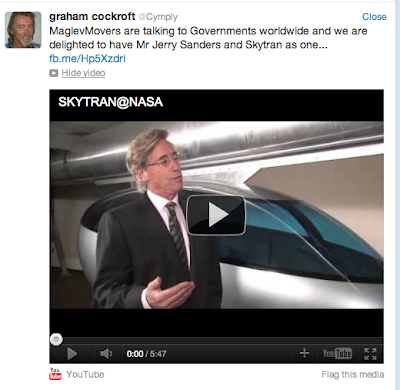Today,
Internet & computer aficionado Michael Fraase tweeted an objection to City Pages editor Kevin Hoffman about
a City Pages article not being properly sourced:Is @citypages' @panopticon13 helping with the WCCO duck/dog story when it uses a single anonymous source?
I thought that was hilarious since Michael Fraase penned
a poorly sourced puff piece for the Utne Reader back in 2003.
Fraase was not amused and
tweeted he stood "fully behind the article" and there were "plenty of facts in the article" Fraase also said I was "willfully disingenuous." Fraase also
directed me to an unedited version of his pod article.
Fraase challenged me to fact-check his article, so here goes:
The first graf claims:
"The future of sustainable motorized transportation is an enclosed driverless golf-cart-on-a-stick [PRT]"
Well, it's nearly nine years since that article and the only "driverless golf-cart-on-a-stick" transport is a few pathetic demonstration models at Heathrow Airport and a basement in the United Arab Emirates - hardly the transportation revolution Frasse and other pod promoters at the time were anticipating.
In his article, Fraase uses the present tense when he describes what PRT can do even though a working, urban PRT system did not exist at the time. For instance, Frasse makes the unproven and bizarrre claim that "PRT moves people the same way the Internet moves data.".
Fraase goes on to claim something that was merely a concept could be less expensive than reality-based transit modes:
Because the cars are simply constructed and lightweight, the guideways can be small, cheap, and cause minimal construction disruption; guideways can be built at an exceptionally low cost of between US$5 million and US$10 million per mile.
Since that article, the only system to go into service has been the ULTra PRT system. Lacking the real-world urban setting that adds complex right-of-way expenses and other costs to transit planning and construction, any comparison is flawed. Transit consultant Michael Setty took look at the rosy cost estimates for PRT in his 2009 white paper (
PDF):
ATS Limited has estimated that its particular PRT design would cost between $7 million and $15 million per one-way guideway mile including infrastructure, stations, control systems and vehicles20. Applying the higher ATS figure to a hypothetical, nearly 100% elevated system in Winona results in an estimate of at least $330 million21. This estimate is probably conservative, since the history of new or unproven transportation technologies shows that outspoken proponents often underestimate likely construction costs.
Frasse makes other claims about the efficiency and convenience of PRT that are completely speculative, not factual such as:
A single PRT guideway’s capacity is roughly the same as that of a four-lane highway.
And:
PRT will likely require no operational subsidy.... A commercial endeavor should be able to operate its PRT system in most metropolitan areas without any sort of operational subsidy while generating a fair profit for its owners
Fraase offers no objective, reality-based evidence for this claim or any of the "facts" such as operating costs. Instead, Frasse links to several pro-PRT websites, the Citizens for Personal Rapid Transit, The PRT-promoting Advanced Transit Association and the moribund Taxi 2000 Corporation. Frasse links to "Personal Rapid Transit at the University of Washington", but that link is to Jerry Schneider's gadgetbahn pages on the faculty.washington.edu website. Schneider is one of the anti-LRT monkey-wrenching
gang out in the Seattle area (comment on Seattle Transit Blog):PRT & the Denver Airport boondoggle show us proprietary “alternative” plans to replace the proven technology of light rail run much larger risks of failure. But, to the benefit of Emory Bundy, Richard Harkness, John Niles, Jim MacIsaac, Jerry Schneider, Bill Eager, Jim Horn….and the rest of Kemper Freeman’s gang, it is very rare that fringe transport ideas ever make it off the drawing board. When they do, things get ugly.
But again, light rail always becomes the punching bag.
I
tweeted to Frasse that his article lacked any credible sources for his facts. I mentioned two leading transit advocacy organizations in MInnesota - The Sierra Club and Transit for Livable Communities.
Fraase
tweeted the folowing:
Cost comparison sources were an NYU economist and someone from U Wash, I believe. TLC would have been great source; space limits.
Fraase's citation of vague sources at universities can best be described as a
fallacious appeal to authority.As for the failure to include TLC as a source because of "space limits"... space limits on a blog?
For the record, TLC and the Sierra Club have resolutions opposing public funding of PRT projects in Minnesota.
Fraase has
another post on his blog (illustrated with a pod) whining that buses don't operate often enough for him. In
another blog post he makes this snide observation:
Traffic gridlock isn’t yet a problem up here on the far edge, but it’s coming and we regularly need unseen yet heard guidance to get from here to there. And getting from here to there up here almost always means an automobile, one Minneapolis city council member’s grand personal rapid transit (PRT) dream notwithstanding.
The link to the passage referring to a Minneapolis Councilman is broken. The link used to go to the CPRT website's page devoted to Dean Zimmermann's PRT plan for Minneapolis....
this Dean Zimmermann. So much for Mr. Fraase's reliable sources.




























